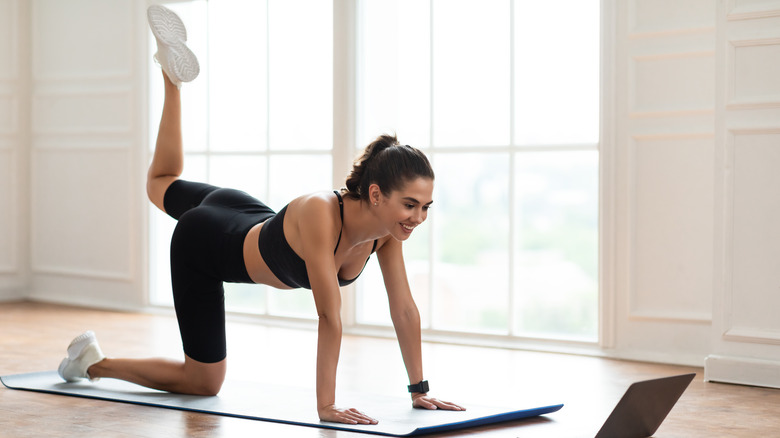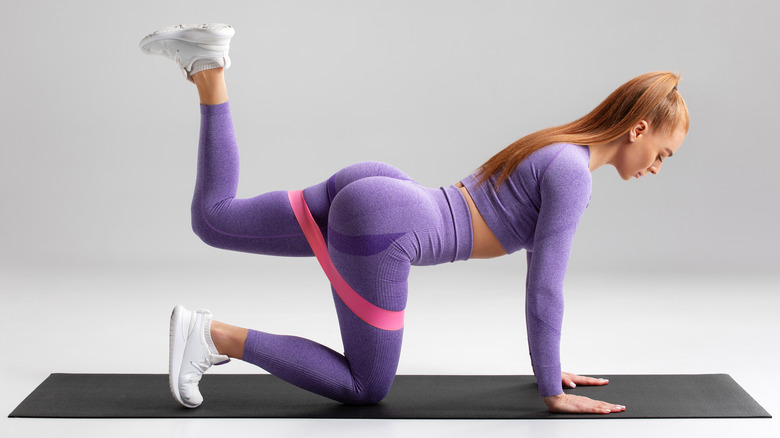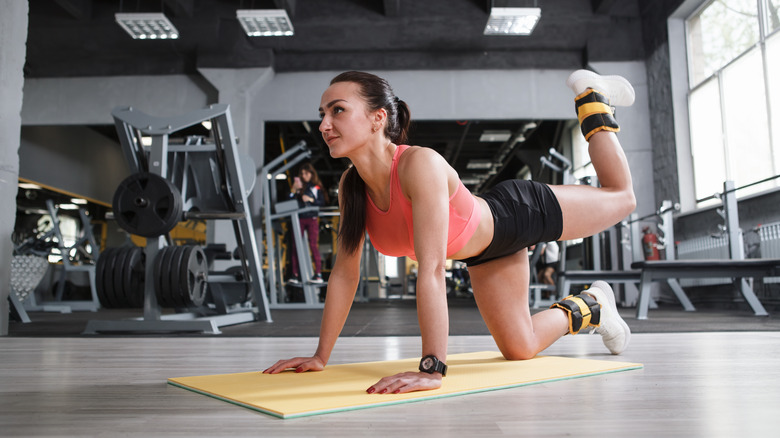Why You Want To Add Donkey Kicks To Your Workout Routine
If you've got a mat and some floor space in your home, you're halfway toward reaching many of your fitness goals.
Something you'll likely hear in the fitness world is the importance of targeting muscle groups during a workout. Our body consists of 11 muscle groups, per Lauren Simpson, and making sure we focus on each of them is an important part of achieving total fitness. Some of the best home workouts are ones that combine a few different movements to target each of those muscle groups. This keeps things interesting and challenging. In fact, variation is often recommended when you want to see sustained progress and also to avoid the risk of injury, according to University Hospitals.
The muscles located in your rear end, known as the glutes, do a lot for your body. Consisting of the gluteus maximus, gluteus medius, and gluteus minimus, your body's gluteal muscles help with posture, balance, and movement, Best Care reports. According to physical therapist Amy Koch, the glutes aid workout routines as a whole. "Strong gluteals are important for proper pelvic alignment, propulsion during walking and running, and even standing on one leg," she explains. If you've been training your glutes at home or at the gym, you may have come across an exercise called donkey kicks. It involves getting down on all fours and kicking one foot back as a donkey would, according to Byrdie. Here's why you want to add this exercise to your workout routine.
Donkey kicks tone the glutes, improve posture, and strengthen the core
Donkey kicks, also known as quadruped bent-knee hip extension, tone your glute muscles, particularly the gluteus maximus and gluteus medius, according to Byrdie. The workout is also built in a way where you have to engage your entire body to perform the kick. You're balancing yourself with one leg while doing so, and this works your arms, core, and hamstrings too, according to fitness coach Tanya Becker. By strengthening the muscles in your glute area, you're also helping your body prevent injuries from other workout moves.
The classic donkey kick, when mastered, is also an easy gateway to more challenging versions of the same exercise using weights or resistance bands, per Today. Sitting in one position for long periods of time can put strain on your glutes, hips, lower back, and neck, per ISSA, and these are often remedied when you pay attention to proper posture and build core strength. Donkey kicks are a great workout for both, according to Byrdie.
Donkey kicks are also a great alternative for those who don't particularly enjoy doing squats during a workout routine, reports ISSA.
How to properly do a donkey kick
Form is everything with donkey kicks as it is with any workout, especially if you want to see progress and avoid injury, per ISSA. Get down on your mat on all fours. Try and keep a straight back and place your palms directly under your shoulders, making sure your knees are hip-width apart. Engage your core as you lift your right leg up behind you, as if you're kicking the air. Focus on engaging your glute muscles as you do so. If you feel your back starting to tense, then you've lifted your leg too far. Bring your leg back to starting position and do the same with the opposite leg.
The most important thing to keep in mind during a donkey kick is to pay attention to your core, according to Today. Your back can get aggravated if your stomach muscles aren't tight enough. Also, pay attention to how your hips are placed throughout the movement. Don't allow the flow of the workout to disturb your balance. Your neck is another area to focus on; it should be aligned with your spine.
Donkey kicks look simple, even though they pack a punch when it comes to how many muscles they train. Even if you hate working out, you're bound to love the results of this exercise if you ever tried it out.


